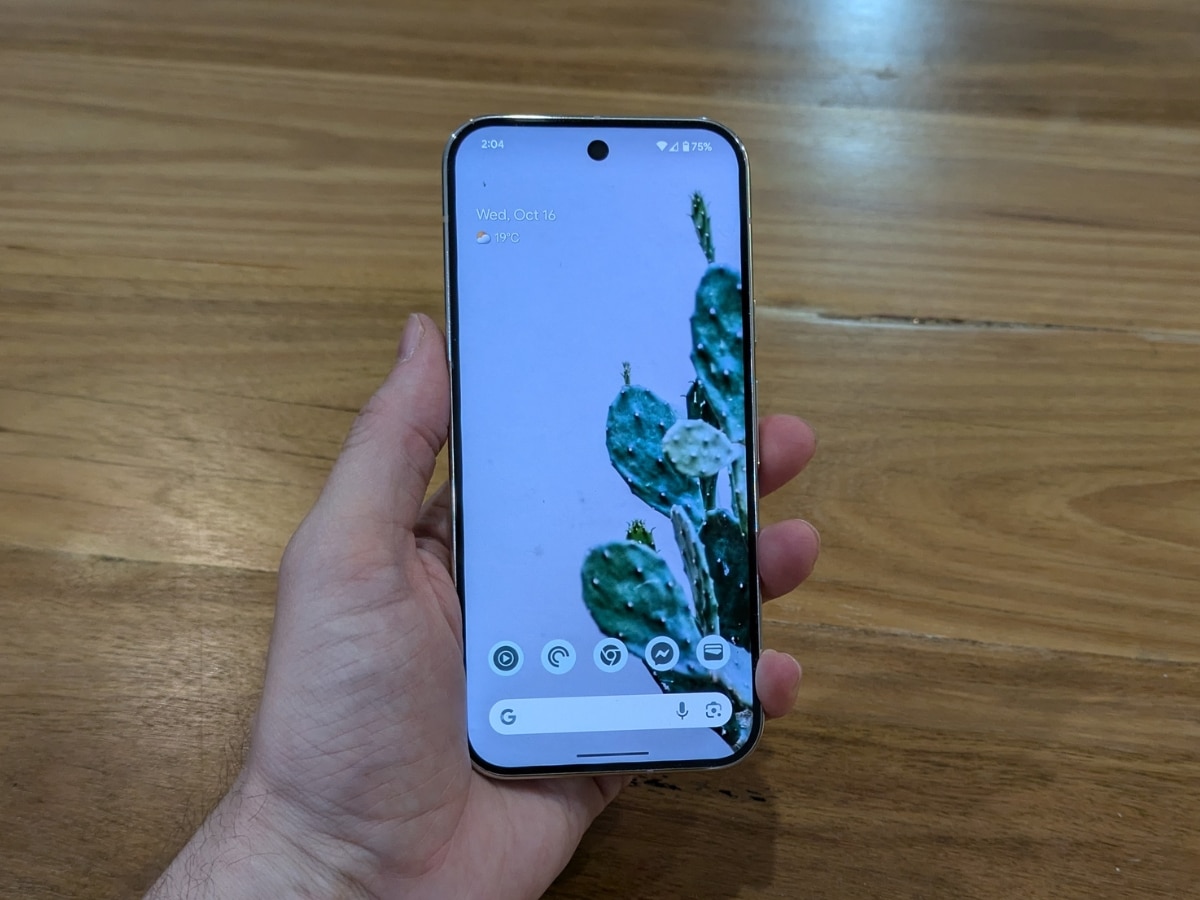
Published:
Readtime: 10 min
Every product is carefully selected by our editors and experts. If you buy from a link, we may earn a commission. Learn more. For more information on how we test products, click here.
I think this year’s flagship phones have a bit of a rough deal. I’ve been testing Google’s Pixel 9 Pro for the past week, and I do genuinely think it’s a great phone – it’s powerful, the screen is bright and vibrant, the sound is clear, and the design is absolutely on point. But, that’s also true for the Pixel 9, Google’s base-level device that I reviewed a little over a month ago, and which shares almost every software improvement the tech company has brought to its 9th generation of Pixel devices.
There are some hardware improvements here, of course: the Pro is snappier due to some extra RAM, has an additional telephoto lens on the (admittedly bulky) camera bump, and its screen is actually a higher resolution despite being the same size. But I can’t help but feel that, when the base model is so impressive, as the Pixel 9 is, the Pro has had some of the wind taken out of its sails.
For a bit of context, I’ve used a lot of Google’s phones over the years: from the original Pixel, to the Pixel 3, 6a, 8a, 9, and now the 9 Pro. I’ve been on this journey with the business since it stepped away from the Nexus branding and delivered its vision for what a flagship Android phone would look like. I say this because I think this generation of phones is the realisation of everything Google has been working towards with its Pixel products – they’re finally a truly high-end, borderline-luxury flagship phone.
It’s just getting harder to justify most of the difference between the Pixel 9 Pro’s $1,699 price tag and the $1,349 baseline Pixel 9 if you’re someone that doesn’t use their phone for content creation. If you’ve got the extra money, and want a higher-end Android device without the added size of the XL or Fold devices, this is absolutely the phone for you.
But, if you’re being hit by the reality of our cost-of-living crisis or aren’t in the content game, it’s not such an easy recommendation.

Comparing the Competition
| Google Pixel 9 Pro | iPhone 16 Pro | Samsung Galaxy S24 Ultra | |
| Price | From AU$1,699 | From AU$1,799 | From AU$1,999 |
| Display | – 6.3” OLED Display – 120Hz refresh rate – 2856 x 1280 resolution – Gorilla Glass Victus 2 | – 6.3” OLED Display – 120Hz refresh rate – 2622 x 1206 resolution – Ceramic Shield Glass | – 6.8” AMOLED – 120Hz refresh rate – 3120 x 1440 resolution – Gorilla Armor |
| Operating System | Android 14 – 15 | iOS 18 | Android 14 – 15, One UI 6.1.1 |
| Internals | – Processor: Google Tensor G4 – RAM: 16GB – Storage: 128GB, 256GB, 512GB, 1TB | – Processor: A18 Pro – RAM: 8GB – Storage: 128GB, 256GB, 512GB, 1TB | – Processor: Qualcomm SM8650-AC Snapdragon 8 Gen 3 – RAM: 12GB – Storage: 256GB, 512GB, 1TB |
| Networking | – 5G – Wi-Fi 7 – Bluetooth 5.3 – NFC Capable | – 5G – Wi-Fi 7 – Bluetooth 5.3 – NFC Capable | – 5G – Wi-Fi 7 – Bluetooth 5.3 – NFC Capable |
| Camera | Front: 42MP ultrawide Rear: 50MP wide, 48MP telephoto, 48MP ultrawide Can video shoot up to 8K@30fps, 4K@60fps, 1080p@240fps | Front: 12MP wide Rear: 48MP wide, 12MP telephoto, 48MP ultrawide Can shoot up to 4K@60fps, 1080p@240fps | Front: 12MP wide Rear: 200MP wide, 10MP telephoto, 50MP telephoto, 12MP ultrawide Can video shoot up to 8K@30fps, 4K@120fps, 1080p@240fps |
| Battery | 4,700mAh | 3,582mAh | 5,000mAh |
| Other features | – Single USB 3.2 Type-C port – Fingerprint reader – Qi Wireless Charging Compatible – IP68 dust/water resistant (up to 1.5m for 30 mins) – Google Gemini | – Single USB 3.2 Type-C port – Face ID – Qi2 Wireless Charging Compatible – IP68 dust/water resistant (up to 6m for 30 mins) – Apple Intelligence | – Single USB 3.2 Type-C port – Fingerprint reader – Qi/PMA Wireless Charging Compatible – Samsung DeX Support – IP68 dust/water resistant (up to 1.5m for 30 mins) – Galaxy AI – Removable stylus |
Designed to Impress
Let’s start with the positives. The Pixel 9 Pro is a beautiful phone. The 6.3’’ screen is bright, hitting a max of 3000 nits at peak brightness, but also delivers a depth of colours thanks to the LTPO OLED display – which is essentially an acronym that means ‘energy efficient screen with a wide colour gamut and variable refresh rate’.
In fact, the Pixel 9 Pro’s refresh rate ranges from 1 to 120Hz, compared to the Pixel 9’s 60 to 120Hz, which is an incredibly interesting change. It essentially means that the phone doesn’t have to refresh the screen 60 times a second if it doesn’t need to, and can cut down on energy usage to deliver better battery efficiency – though not necessarily better battery life, since the screen is a higher resolution, is brighter, and the battery isn’t any bigger than the base Pixel 9.
Google claims that on battery saver mode the phone can last around 100 hours, but in my more regular use-case, the phone was running at around 30 per cent when I was getting into bed at night.
The screen is not quite an edge-to-edge display, but it’s very close, and bordered by a polished metal frame and buttons that elevate the device into a high-end smartphone. That frame was actually the first thing I noticed when I pulled the device out of its box, and was left suitably impressed. It’s a shame that we almost always cover our phones with cases since the industrial designers at these companies are really doing some fantastic work, but if I drop $1,699 on a new phone I’d 100 per cent protect it with some kind of case.
The second thing I noticed was the phone’s heft. It isn’t actually that heavy, weighing in at about 200 grams, but the Pixel 9 Pro feels hefty in the hand which adds to the high-end feel.

Top-tier Performance
The Pixel 9 Pro features the same Tensor G4 chip as the Pixel 9, and so everything I found in that review rings true here too. It’s an impressive chip that honestly goes totally unseen: in my week of testing I didn’t have any slow downs, hiccups, or crashes. It just works.
The main difference is the additional RAM. The regular Pixel 9 comes with 12GB of onboard RAM, whereas the Pixel 9 Pro, Pro XL and Fold have 16GB. For most use cases I would say that extra RAM isn’t necessary, honestly, but if you’re a content creator, a videographer, a photographer, or any other creative that works primarily on their phone, that difference could be massive.
That extra RAM should also go a long way to helping higher-end or demanding games maintain a steady frame rate. I tested Genshin Impact, and it did run better than on the base Pixel 9. It still runs hot when playing bigger, more graphically demanding games, and was getting uncomfortable to hold after just 15 minutes or so.
I should add here that while I did test the phone’s AI capabilities for this review – my thoughts haven’t really changed since the Pixel 9 launched, which is that it all works seamlessly and without much issue – I’m just not really sure what value it is really bringing to users.
Sure, you can ask it to do things you could already do (like figure out how to get home, or ask it questions you could’ve just Googled yourself), but there isn’t much *new* added to the daily experience of using a phone. Yet.

A Phone for Making ‘Content’
The Pixel line has always been known for the quality of its camera, and the 9 Pro delivers some important improvements to the Pixel 9’s already stellar photography experience. For starters, the phone adds a third lens to the camera bump: featuring a 50 megapixel wide-angle lens, a 48 megapixel ultrawide-angle lens, and a 48 megapixel telephoto lens with up to five times optical zoom.
Additionally, the Pro delivers the ability to zoom in at 30 times the phone’s base lens, due to a “Super Res Zoom” feature. It’s impressive, but the photos taken aren’t exactly clear – clearer than another phone, maybe, but not something I’d want to hang on my walls.
The phone does also feature a much higher resolution selfie cam: 42 megapixels, compared to the Pixel 9’s 10 megapixel front-facing cam, which, again, seems to point more so to content creators than those of us that take the occasional selfie for fun.



If video is more your speed, the Pixel 9 Pro can video at up to 4k resolution at 24, 30 or 60 frames per second, and will actually be able to film at up to 8k resolution, capped at 30fps, later this year by way of its upcoming AI-enhanced ‘Video Boost’ software. It seems like it’ll take your 4k footage and use AI to upscale the resolution, so it won’t doesn’t need any additional hardware to ‘film’ at 8k (apart from Google’s nuclear-powered AI databanks, of course)
At first, I was wondering who needed to shoot in 8k, but then I realised that YouTube actually supports videos up to 8k. So, theoretically, if Google wants more 8k footage on YouTube, it makes sense to put an 8k-capable phone out there in the wild for content creators to easily get their hands on. I’m not a conspiracy theorist or anything, but I think I’ve got your number, Google.
In fairness, this is probably the most interesting consumer-facing use-case I’ve seen for AI yet, it’s just that it feels like it’s solving a problem that doesn’t exist yet.

Is it Worth the Upgrade?
Now the sticky question. When you put the Pixel 9 Pro up against its little brother, it certainly does have a bunch of extra features, but most of them are not particularly useful unless you’re in the content game. Being able to (eventually) shoot 8k video is great and all, but most people don’t have an 8k capable screen – hell, the Pixel 9 Pro doesn’t have an 8k screen, so you can’t even enjoy the upscaled videos on the phone you take it with.
The added boost to RAM is a nice addition and will definitely help with rendering large video files, as well as running more complex and demanding games (or even streaming them using something like Xbox Game Pass).
The bottom line is that if you want the best possible Google phone without the added size of an XL or Fold, this is it. It’s beautifully made, and is honestly the most premium-feeling phone I’ve held. The higher-res selfie camera is impressive, as is the phone’s performance, but you’ve got to ask yourself if those improvements are worth a $350 premium on the base Pixel, which, as I found during my review, is a fantastic phone.
You Might Like:

































Comments
We love hearing from you. or to leave a comment.